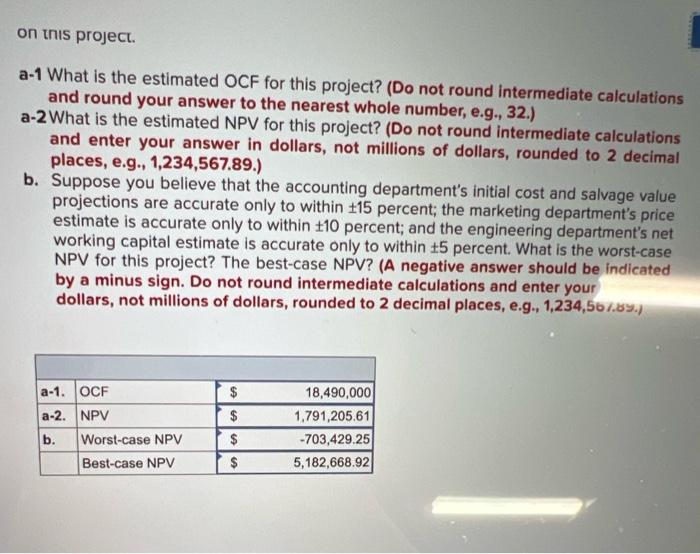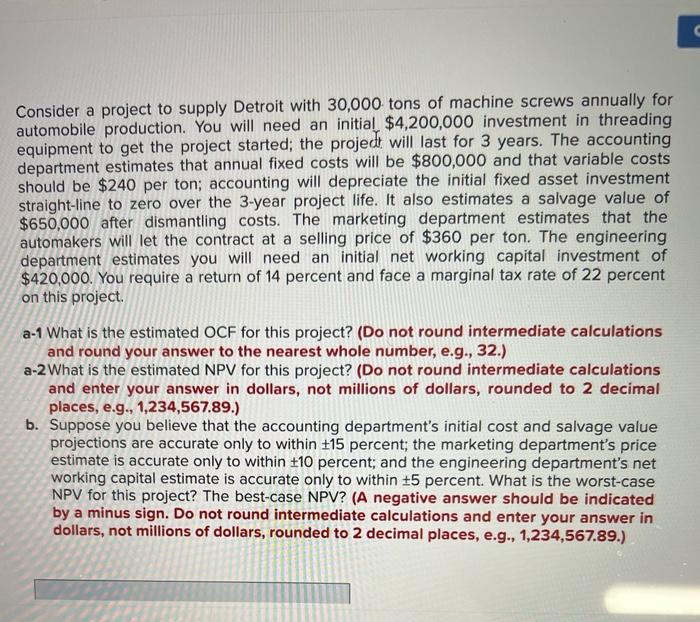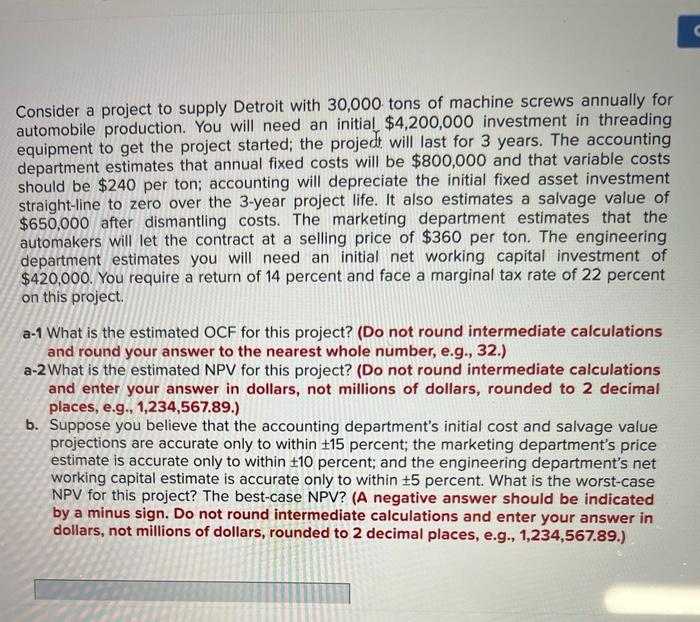this is thew full qyestion
on this project. a-1 What is the estimated OCF for this project? (Do not round intermediate calculations and round your answer to the nearest whole number, e.g., 32.) a-2 What is the estimated NPV for this project? (Do not round intermediate calculations and enter your answer in dollars, not millions of dollars, rounded to 2 decimal places, e.g., 1,234,567.89.) b. Suppose you believe that the accounting department's initial cost and salvage value projections are accurate only to within 215 percent; the marketing department's price estimate is accurate only to within 110 percent; and the engineering department's net working capital estimate is accurate only to within t5 percent. What is the worst-case NPV for this project? The best-case NPV? (A negative answer should be indicated by a minus sign. Do not round intermediate calculations and enter your dollars, not millions of dollars, rounded to 2 decimal places, e.g., 1,234,567.89.) $ a-1. OCF a-2. NPV b. Worst-case NPV Best-case NPV $ $ 18,490,000 1.791,205.61 -703,429.25 5,182,668.92 $ Consider a project to supply Detroit with 30,000 tons of machine screws annually for automobile production. You will need an initial $4,200,000 investment in threading equipment to get the project started; the project will last for 3 years. The accounting department estimates that annual fixed costs will be $800,000 and that variable costs should be $240 per ton; accounting will depreciate the initial fixed asset investment straight-line to zero over the 3-year project life. It also estimates a salvage value of $650,000 after dismantling costs. The marketing department estimates that the automakers will let the contract at a selling price of $360 per ton. The engineering department estimates you will need an initial networking capital investment of $420,000. You require a return of 14 percent and face a marginal tax rate of 22 percent on this project. a-1 What is the estimated OCF for this project? (Do not round intermediate calculations and round your answer to the nearest whole number, e.g., 32.) a-2 What is the estimated NPV for this project? (Do not round intermediate calculations and enter your answer in dollars, not millions of dollars, rounded to 2 decimal places, e.g., 1,234,567.89.) b. Suppose you believe that the accounting department's initial cost and salvage value projections are accurate only to within 15 percent; the marketing department's price estimate is accurate only to within #10 percent; and the engineering department's net working capital estimate is accurate only to within +5 percent. What is the worst-case NPV for this project? The best-case NPV? (A negative answer should be indicated by a minus sign. Do not round intermediate calculations and enter your answer in dollars, not millions of dollars, rounded to 2 decimal places, e.g., 1,234,567.89.) Consider a project to supply Detroit with 30,000 tons of machine screws annually for automobile production. You will need an initial $4,200,000 investment in threading equipment to get the project started; the project will last for 3 years. The accounting department estimates that annual fixed costs will be $800,000 and that variable costs should be $240 per ton; accounting will depreciate the initial fixed asset investment straight-line to zero over the 3-year project life. It also estimates a salvage value of $650,000 after dismantling costs. The marketing department estimates that the automakers will let the contract at a selling price of $360 per ton. The engineering department estimates you will need an initial networking capital investment of $420,000. You require a return of 14 percent and face a marginal tax rate of 22 percent on this project. a-1 What is the estimated OCF for this project? (Do not round intermediate calculations and round your answer to the nearest whole number, e.g., 32.) a-2 What is the estimated NPV for this project? (Do not round intermediate calculations and enter your answer in dollars, not millions of dollars, rounded to 2 decimal places, e.g., 1,234,567.89.) b. Suppose you believe that the accounting department's initial cost and salvage value projections are accurate only to within 15 percent; the marketing department's price estimate is accurate only to within #10 percent; and the engineering department's net working capital estimate is accurate only to within +5 percent. What is the worst-case NPV for this project? The best-case NPV? (A negative answer should be indicated by a minus sign. Do not round intermediate calculations and enter your answer in dollars, not millions of dollars, rounded to 2 decimal places, e.g., 1,234,567.89.) on this project. a-1 What is the estimated OCF for this project? (Do not round intermediate calculations and round your answer to the nearest whole number, e.g., 32.) a-2 What is the estimated NPV for this project? (Do not round intermediate calculations and enter your answer in dollars, not millions of dollars, rounded to 2 decimal places, e.g., 1,234,567.89.) b. Suppose you believe that the accounting department's initial cost and salvage value projections are accurate only to within 215 percent; the marketing department's price estimate is accurate only to within 110 percent; and the engineering department's net working capital estimate is accurate only to within t5 percent. What is the worst-case NPV for this project? The best-case NPV? (A negative answer should be indicated by a minus sign. Do not round intermediate calculations and enter your dollars, not millions of dollars, rounded to 2 decimal places, e.g., 1,234,567.89.) $ a-1. OCF a-2. NPV b. Worst-case NPV Best-case NPV $ $ 18,490,000 1.791,205.61 -703,429.25 5,182,668.92 $ Consider a project to supply Detroit with 30,000 tons of machine screws annually for automobile production. You will need an initial $4,200,000 investment in threading equipment to get the project started; the project will last for 3 years. The accounting department estimates that annual fixed costs will be $800,000 and that variable costs should be $240 per ton; accounting will depreciate the initial fixed asset investment straight-line to zero over the 3-year project life. It also estimates a salvage value of $650,000 after dismantling costs. The marketing department estimates that the automakers will let the contract at a selling price of $360 per ton. The engineering department estimates you will need an initial networking capital investment of $420,000. You require a return of 14 percent and face a marginal tax rate of 22 percent on this project. a-1 What is the estimated OCF for this project? (Do not round intermediate calculations and round your answer to the nearest whole number, e.g., 32.) a-2 What is the estimated NPV for this project? (Do not round intermediate calculations and enter your answer in dollars, not millions of dollars, rounded to 2 decimal places, e.g., 1,234,567.89.) b. Suppose you believe that the accounting department's initial cost and salvage value projections are accurate only to within 15 percent; the marketing department's price estimate is accurate only to within #10 percent; and the engineering department's net working capital estimate is accurate only to within +5 percent. What is the worst-case NPV for this project? The best-case NPV? (A negative answer should be indicated by a minus sign. Do not round intermediate calculations and enter your answer in dollars, not millions of dollars, rounded to 2 decimal places, e.g., 1,234,567.89.) Consider a project to supply Detroit with 30,000 tons of machine screws annually for automobile production. You will need an initial $4,200,000 investment in threading equipment to get the project started; the project will last for 3 years. The accounting department estimates that annual fixed costs will be $800,000 and that variable costs should be $240 per ton; accounting will depreciate the initial fixed asset investment straight-line to zero over the 3-year project life. It also estimates a salvage value of $650,000 after dismantling costs. The marketing department estimates that the automakers will let the contract at a selling price of $360 per ton. The engineering department estimates you will need an initial networking capital investment of $420,000. You require a return of 14 percent and face a marginal tax rate of 22 percent on this project. a-1 What is the estimated OCF for this project? (Do not round intermediate calculations and round your answer to the nearest whole number, e.g., 32.) a-2 What is the estimated NPV for this project? (Do not round intermediate calculations and enter your answer in dollars, not millions of dollars, rounded to 2 decimal places, e.g., 1,234,567.89.) b. Suppose you believe that the accounting department's initial cost and salvage value projections are accurate only to within 15 percent; the marketing department's price estimate is accurate only to within #10 percent; and the engineering department's net working capital estimate is accurate only to within +5 percent. What is the worst-case NPV for this project? The best-case NPV? (A negative answer should be indicated by a minus sign. Do not round intermediate calculations and enter your answer in dollars, not millions of dollars, rounded to 2 decimal places, e.g., 1,234,567.89.)









